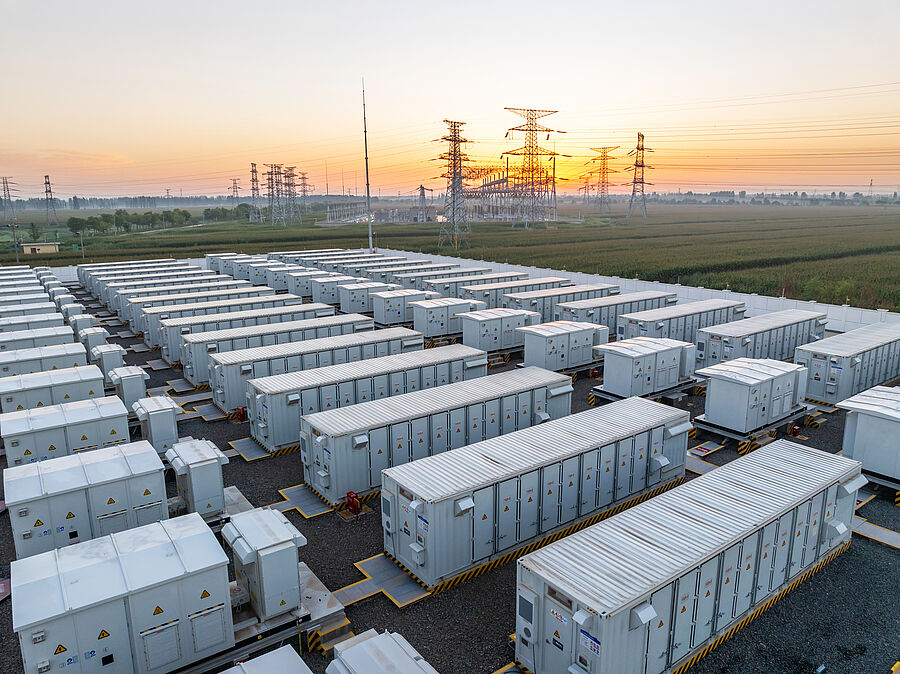General information on the INNOnet project
The INNOnet project is testing dynamic electricity grid fees for end consumers in three demonstration areas in Austria (the grid areas of Netz Oberösterreich GmbH, LINZ NETZ GmbH, and Energienetze Steiermark GmbH). We aim to test during the demonstration period from August 2025 to July 2026 whether and how end consumers change their electricity consumption behavior due to altered, dynamic grid fees. Our demonstration participants will have different electricity grid fees calculated on their electricity bills – however, we ensure that these fees cannot be higher than in the previous grid fee scheme. Participants in the demonstration can therefore save money, but they will pay at most their previous fees. Additionally, the grid fees have been approved by the regulatory authority E-Control (Regulatory Sandbox).
In Austria, the electricity bill consists of three components: the energy costs (these are the pure costs for the electricity), the network costs (which cover the costs for the construction, renewal, expansion, and operation of the electricity grids), and taxes and levies (e.g., levies for the promotion of renewable energy or the electricity levy). In the INNOnet project, we are changing the network cost component for certain demo participants: we are dynamicizing the network tariff (to incentivize end customers to avoid load peaks and promote the consumption of locally produced electricity). In our mobile INNOnet app, we display energy costs and an estimate of taxes/levies along with the network costs, but we do not alter these components.
You will find information on the network tariff/network costs and energy tariff/energy costs in the INNOnet project app. In the total cost display, taxes/levies are also included along with the network and energy costs, but they may not fully align with those on your electricity bill. All cost components are always displayed including VAT (gross).
A Regulatory Sandbox allows for exceptions to be created in the regulated area of the energy sector for the purpose of research and development. In Austria, a corresponding framework for Regulatory Sandboxes was established as part of the Renewable Expansion Act package. Exceptions from grid fees for research and demonstration projects can be requested (see § 58a ElWOG in the electricity sector).
E-Control is the Austrian regulatory authority for the electricity and gas market. It ensures transparent and fair market conditions, monitors compliance with regulations and promotes competition in the energy sector. E-Control also ensures that energy is supplied safely, efficiently and at fair prices. E-Control provides consumers with comprehensive information and advice on energy issues and supports them with concerns or complaints relating to energy suppliers.
All results from the project will be published here on the project homepage.
During the demo period, you can contact projekt.innonet(at)ait.ac.at with any questions. For more information, please visit the project homepage.
Information on meter point number, grid operator and electricity supplier
You have received an email or letter from your grid operator for demo participation (either Netz Oberösterreich GmbH or LINZ NETZ GmbH). If you live in Styria, you may have been invited to participate in a workshop (grid operator: Energienetze Steiermark GmbH). End consumers from other grid areas cannot participate in the project.
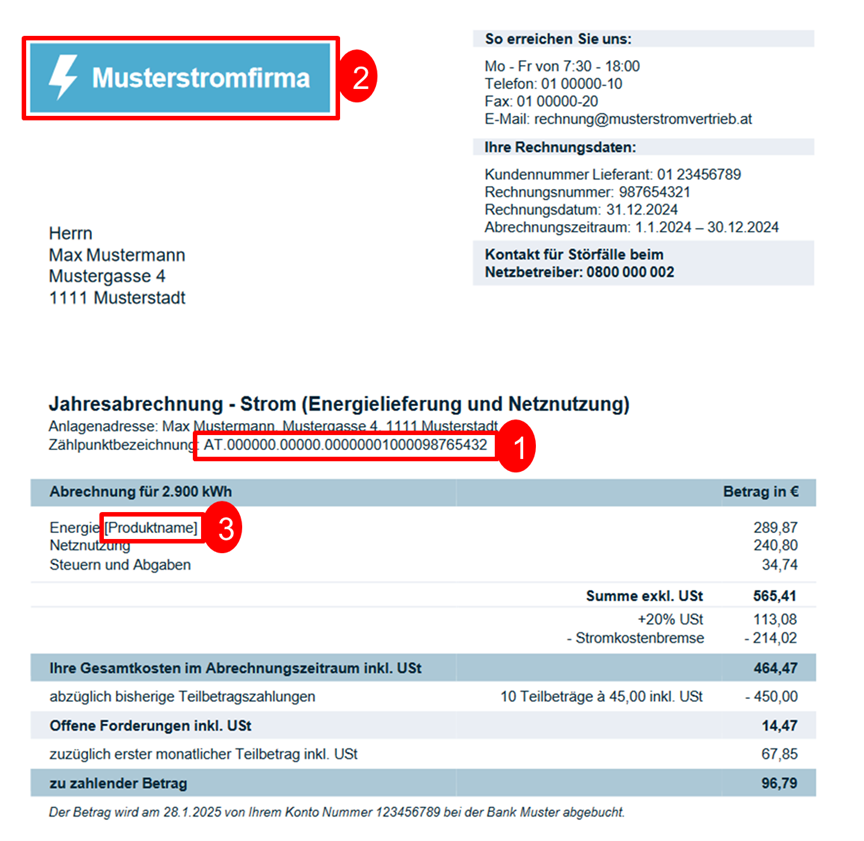
Your metering point numbers were included in the email/letter from the grid operator (Netz Oberösterreich GmbH und LINZ NETZ GmbH). Alternatively, you can find your metering point number on your electricity bill (or grid bill): The metering point number consists of 31 digits and starts with the two letters "AT". You may have multiple metering point numbers (e.g., one for consumption and one for your photovoltaic feed-in). Please enter all metering point numbers for your household during the registration process on the mobile INNOnet project app.
The metering point number (also known as "Zählpunktbezeichnung") is shown on the sample invoice from E-Control (see graphic) in the red box under Number 1.
Source example invoice: https://www.e-control.at/konsumenten/rechnung/rechnungsgestaltung-rechnungslegung
You can find the name of your electricity supplier on your electricity bill, unless you have recently switched. A list of electricity suppliers operating in Austria can be found on the website of the regulatory authority E-Control: https://www.e-control.at/konsumenten/strom/lieferanten-uebersicht/oesterreichweit
The name of the electricity supplier is shown on the sample invoice from E-Control (see graphic) in the red box under Number 2.
Source example invoice: https://www.e-control.at/konsumenten/rechnung/rechnungsgestaltung-rechnungslegung

You can find the name of your electricity tariff on your electricity bill (see on the sample invoice from E-Control in the red box under Number 3).
Source example invoice: https://www.e-control.at/konsumenten/rechnung/rechnungsgestaltung-rechnungslegung
You can find your current electricity grid charges under the following links:
Project participation
- Households eligible for participation in the demo will receive a letter from Netz Oberösterreich GmbH.
- In this letter, you will be led to the project INNOnet page of the grid operator.
- There, you will be asked to fill out a survey regarding your household data (e.g., whether you have a PV system, a heat pump, or an electric car). Filling out the survey is essential for participating in the project.
- The survey will then guide you directly to download the mobile INNOnet project app from the App Store/Google Play Store. After downloading the INNOnet project app, you will be prompted to enter your metering point number(s), grid operator, energy supplier, and energy tariff (you can skip entering the project key for now; you will receive it shortly before the demo period).
- To allow us to use your consumption data from your smart meter devices, as a final step, you must give your consent for data processing and transmission ("Consent Management") in the grid operator's portal (Link eService-Portal Netz Oberösterreich). The exact process of this will be explained below.
- You will find out within 2 months of registration whether you have been selected for demo participation.
- If you are not selected for the demo, you will be assigned to the control group (you will not receive different grid fees, but you will have the opportunity to track your energy consumption via the INNOnet project app and participate in an attractive prize draw – see question below).
- Households eligible for participation in the demo will receive an e-mail from LINZ NETZ GmbH.
- In this e-mail, you will be led to the project INNOnet page of the grid operator.
- There, you will be asked to fill out a survey regarding your household data (e.g., whether you have a PV system, a heat pump, or an electric car). Filling out the survey is essential for participating in the project.
- The survey will then guide you directly to download the mobile INNOnet project app from the App Store/Google Play Store. After downloading the INNOnet project app, you will be prompted to enter your metering point number(s), grid operator, energy supplier, and energy tariff (you can skip entering the project key for now; you will receive it shortly before the demo period).
- To allow us to use your consumption data from your smart meter devices, as a final step, you must give your consent for data processing and transmission ("Consent Management") in the grid operator's portal (Serviceportal Linz Netz). The exact process of this will be explained below.
- You will find out within 2 months of registration whether you have been selected for demo participation.
- If you are not selected for the demo, you will be assigned to the control group (you will not receive different grid fees, but you will have the opportunity to track your energy consumption via the INNOnet project app and participate in an attractive prize draw – see question below).
- Households eligible for participation in the demo will be encouraged to participate through workshops organized by the respective grid operator (Energienetze Steiermark GmbH).
- During the workshop, you will be asked to fill out a survey regarding your household data (e.g., whether you have a PV system, a heat pump, or an electric car). Filling out the survey is essential for participating in the project.
- There will be another workshop where the mobile INNOnet project app will be introduced, and each demo participant will download it. After downloading the INNOnet project app, you will be prompted to enter a project key, which you will receive during the workshop for the mobile INNOnet project app, as well as your metering point number(s), grid operator, energy supplier, and energy tariff.
- To allow us to use your consumption data from your smart meter devices, as a final step, you must give your consent for data processing and transmission ("Consent Management") in the grid operator's portal (Serviceportal Energienetze Steiermark). The exact process of this will be explained below.
The demo period is set from August 2025 to July 2026. You have been informed via the app about the demo start. The network operators (Netz Oberösterreich, Linz Netz) started contacting possible households in February 2025. It is currently no longer possible to join the project.
Unfortunately, no. We limit our project to primary residences.
If you wish to participate in the project, have filled out the survey, downloaded the mobile INNOnet project app, and provided data sharing consent in the service portal of your grid operator, the 15-minute electricity consumption data from the previous day will be automatically sent via the EDA portal to our database developer HAKOM, where it will be stored for the duration of the project. The mobile INNOnet project app from the FH Oberösterreich accesses your consumption data from there and provides it to you. Additionally, the AIT Austrian Institute of Technology accesses this data to calculate grid tariff windows for the following day. The survey data (e.g., household characteristics) will only be made available to research partners (Energy Institute at JKU and AIT Austrian Institute of Technology) for impact analyses.
For demo participants who install a customer interface, these near-real-time data will also be stored on the HAKOM data platform and retrieved by FH Oberösterreich for display in the Project-INNOnet app.
All your data will be anonymized after the end of the project (no later than August 2026).
All data protection-related documents and the terms and conditions can be accessed at the following link: LINK
INNOnet Grid tariff information
Demo participants in the network area of Netz Oberösterreich GmbH are billed with the following modified electricity grid tariffs (you can generate savings, and there will never be higher grid costs than in the old tariffing scheme):
Based on daily network simulations for the following day, there are hours where the following three cases can occur:
- Uncritical hours for the electricity grid,
- Potentially hours with high voltage or transformer load in the grid with an increased expected local renewable input, or
- Potentially hours with low voltage with high expected consumption.
From this, the grid tariff windows are derived, indicating when Case 1, Case 2, or Case 3 will occur for the following day. These specific grid tariff windows and grid tariff levels are communicated through the app at 4 PM the day before. The grid tariff levels for the three cases are shown in the following table:
| Case | Netztarifhöhe |
|---|---|
| Case 1 | 6.8 ct/kWh |
| Case 2 | 0 ct/kWh if consumption is greater than 0.25 kWh/quarter hour (=1 kW), 6.8 ct/kWh if consumption is less than 0.25 kWh/quarter hour (=1 kW) |
| Case 3 | 13.6 ct/kWh if consumption is greater than 0.5 kWh/quarter hour (=2 kW), 20.4 ct/kWh if consumption is greater than 1.0 kWh/quarter hour (=4 kW), 6.8 ct/kWh if consumption is less than 0.5 kWh/quarter hour (=2 kW) |
These grid tariff levels allow you to potentially save on network costs based on your consumption behavior during different times of the day.
Example calculation for electricity cost savings:
The Huber family consumes 4,000 kWh annually. With the standard network tariff for 2025 in the Netz Oberösterreich GmbH network area of 6.8 cents per kilowatt-hour, the total network costs for the year amount to € 320, including the network fee.
If the Huber family moves part of their consumption (e.g., washing machine, dishwasher), specifically 503 kWh, into off-peak hours and avoids consuming during peak hours (or only below the performance threshold of 2 kW), the family can save € 64 per year. This assumption is based on the fact that part of the consumption (1.2 kWh per day) already falls by chance during off-peak hours, which are not priced in the new network tariff design. Additionally, the network fee is eliminated in this network tariff design, allowing the household to save a total of € 100 per year.
Demo participants in the network area of LINZ NETZ are billed with the following modified electricity grid tariffs (you can generate savings, and there will never be higher grid costs than in the old tariffing scheme):
In this tariff scheme, a capacity-based tariff structure is intended to be applied. The highest 15-minute peak load occurring each day is priced at 32.3 ct/kW/day.
Excluded from the peak load determination and thus this pricing are certain time windows ("sun windows"): Due to increased renewable electricity input (e.g., during sunny midday hours), increased consumption would relieve the electricity grid, so there should be no pricing of the peak load during these hours. These "sun windows" will be communicated through the mobile INNOnet project app at 4 PM the day before for the following day. You will also be informed about the peak 15-minute load from the previous day.
You can potentially save on network costs by lowering your peak demand and/or shifting demand into the “sun windows”.
Example calculation for electricity cost savings:
The Huber family consumes 4,000 kWh annually. With the standard network tariff for 2025 in the LINZ NETZ GmbH network area of 5.7 cents per kilowatt-hour, the total network costs for the year amount to € 276, including the network fee.
If the Huber family now shifts their highest daily load peaks to hours of the solar window, which are not priced, and smooths their overall load curve throughout the day (to an average of 1.5 kW per day), the family can save € 100 per year.
Demo participants in the network area of Energienetze Steiermark are billed with the following modified electricity grid tariffs (you can generate savings, and there will never be higher grid costs than in the old tariffing scheme):
Based on daily network simulations for the following day, there are hours where the following three cases can occur:
- Uncritical hours for the electricity grid,
- Potentially hours with high voltage or transformer load in the grid with an increased expected local renewable input, or
- Potentially hours with low voltage with high expected consumption.
From this, the grid tariff windows are derived, indicating when Case 1, Case 2, or Case 3 will occur for the following day. These specific grid tariff windows and grid tariff levels are communicated through the app at 4 PM the day before. The grid tariff levels for the three cases are shown in the following table:
| Case | Grid Tariff Level |
|---|---|
| Case 1 | 9,6 ct/kWh |
| Case 2 | 0 ct/kWh |
| Case 3 | 19.1 ct/kWh |
These grid tariff levels allow you to potentially save on network costs based on your consumption behavior during different times of the day.
Example calculation for electricity cost savings:
The Huber family consumes 4,000 kWh annually. With the standard network tariff for 2025 in the Energienetze Steiermark GmbH network area of 9.6 cents per kilowatt-hour, the total network costs for the year amount to € 432, including the network fee.
If the Huber family moves part of their consumption (e.g., washing machine, dishwasher), specifically 229 kWh, into off-peak hours and avoids consuming during peak hours (or only below the performance threshold of 2 kW), the family can save €64 per year. This assumption is based on the fact that part of the consumption (1.2 kWh per day) already falls by chance during off-peak hours, which are not priced in the new network tariff design. Additionally, the network fee is eliminated in this network tariff design, allowing the household to save a total of €100 per year.
No. Within the demo, we are obligated to not charge end consumers higher grid fees than those existing (according to the System Use Fee Regulation). As a demo participant, you can save on grid fees, but under no circumstances will you pay higher grid fees. However, our project does not have any influence on your energy tariff.
Project INNOnet App
To participate in the demo, you will be contacted directly by the grid operator via email or post. There, you will be directed to a survey through the project INNOnet page of your network operator that is required for participation. At the end of the survey, you will be guided directly to download the mobile INNOnet project app from the App Store/Google Play Store. You will then need to download the app.
The app can generally be found in the App Store/Google Play Store under the name "Projekt-INNOnet"; however, for demo participation, you must have completed the household data survey and enter the project key (you will receive it shortly before the demo phase).
To participate in the demo, you will be invited directly by the network operator to workshops. In the summer, there will be a workshop on using the project INNOnet app. During the workshop, you will receive assistance to download the mobile project INNOnet app from the App Store/Google Play Store via a QR code.
The app can generally be found in the App Store/Google Play Store under the name Project INNOnet. However, to participate in the demo, you must have completed the survey on household data and entered the project key you received during the network operator's workshop.
The mobile INNOnet project app is required for demo participation (without the app and a completed survey, unfortunately, you cannot participate). The mobile INNOnet project app will display the grid fees for the next day at 4 PM (depending on the grid fee scheme), provide you with current information on your electricity costs, and also show your energy consumption. There are no costs associated with using the app.
If you have signed up for your electricity tariff a long time ago, it may not be available in our database. In this case, we kindly ask you to send an email (Subject "INNOnet: My electricity tariff is not available in the app") with a photo or scan of your latest annual electricity bill to tounify (tariff(at)tounify.io).
Here you will find a detailed guide for Netz Oberösterreich: LINK
Here you will find a detailed guide for LINZ NETZ : LINK
Here you will find a general guide: LINK
Thanks to KEM Naturpark Almenlandfor preparing the guide for data transmission and processing for Energienetze Steiermark!
Before Customer Consent Management (CCM) requests can be issued for the project INNOnet app, the quarter-hourly data readout must be activated in the network operator portal. This setting makes it possible to record detailed consumption data at 15-minute intervals and is a precondition for being able to use the app functions at all.
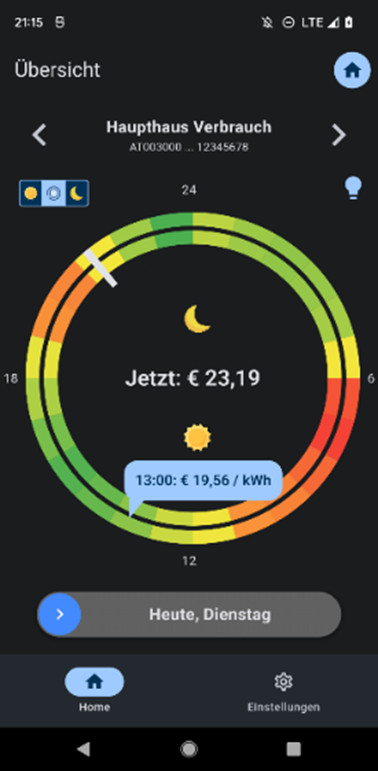
When logged into the INNOnet project app, you will see two circles, which can have different colors. The inner circle represents your grid tariff for the entire current or next day (0 to 24 hours), while the outer circle represents the energy tariff of your energy supplier, which you selected during registration. All tariffs are displayed including VAT (gross). If you click on a specific point in the circle, you will see the tariff applicable at that time.
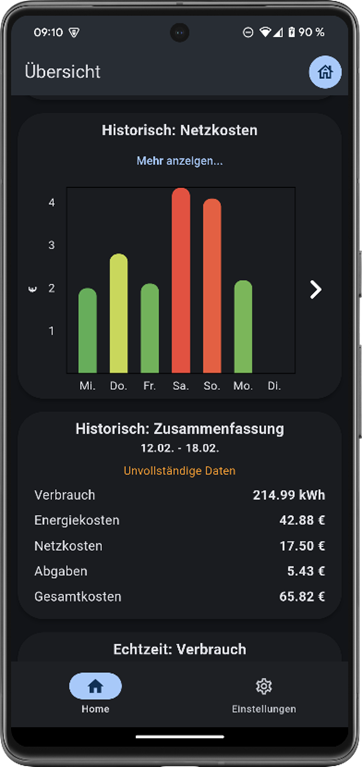
A summary of the total costs (weekly) can be found in the lower section of the app under "Historical: Summary" (see app screenshot). All cost components (energy costs, grid costs, fees, and total costs) are displayed including VAT (gross).
In your INNOnet project mobile app, we try to record and sum up your energy costs, grid fees, and taxes/levies. However, it may occur that we cannot fully capture certain taxes/levies, or that certain electricity suppliers offer special promotions (e.g., free electricity days), which we are unable to represent. In addition, the grid tariffs for Renewable Energy Community participants cannot be displayed in full. Therefore, the INNOnet project mobile app can only approximate your total electricity costs.
On your INNOnet billing information, you will receive the correct grid costs after the demo year. Please refer to your supplier’s electricity bill for the correct energy costs. The representation of the cost components in the app is not legally binding, and deviations may occur.
In the INNOnet project app, you will find information on the grid tariff/grid costs and the energy tariff/energy costs. In the total cost display, taxes/levies are included in addition to grid and energy costs, but these do not necessarily match 100% with those shown on your electricity bill (see above). All cost components are always displayed including VAT (gross).
Currently, multiple people can only view the same data by using the same account. This requires sharing the login credentials (email address and password). If your account was created using Apple or Google, we recommend setting an additional password in the app settings to make access easier.
Yes, you can add a password to your existing account. Simply go to the app settings and set a password. This password will then be used as an additional login method. Make sure to log in using the email address you used during registration.
Note: If you chose the "Hide My Email" option when signing in with Apple, you will need to use the generated email address, as we do not have access to your real email address.
In the app settings, you will find an option to permanently delete all your data, including your account. A deleted account cannot be restored.
Go to the app settings and select the option to change your email address. Enter the new email address and confirm it via the link you will receive by email. After verification, your old email address will become invalid, and you will usually be logged out automatically. If not, please log out manually and then log back in with your new email address.
Go to the app settings and select the "Change Password" option. First, enter your current password, then the new password you would like to use. Confirm the change to save the new password.
If you have changed your electricity supplier after app registration, we kindly ask you to adjust this in the mobile Project-INNOnet app.
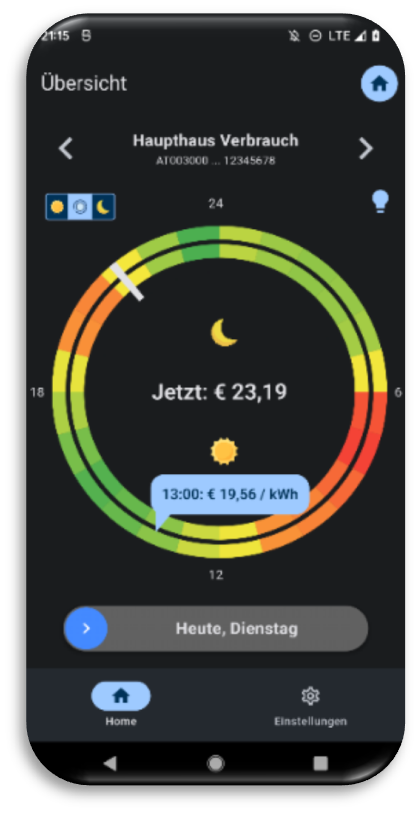
When logged into the INNOnet project app, you will see two circles, which can have different colors. The inner circle represents your grid tariff for the entire current or next day (0 to 24 hours), while the outer circle represents the energy tariff of your energy supplier, which you selected during registration. All tariffs are displayed including VAT (gross). If you click on a specific point in the circle, you will see the tariff applicable at that time.
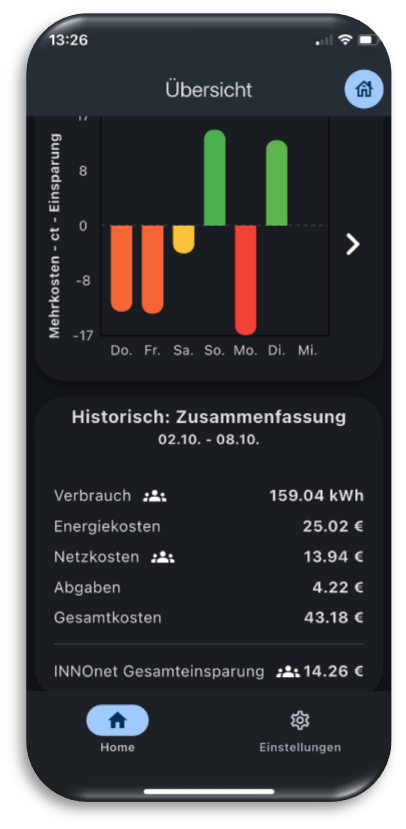
In the INNOnet project app, the total savings are displayed as a figure (at the very bottom). All cost components in the app are shown on a gross basis (including VAT). A positive value indicates savings (a credit). In addition, the chart “Historical: INNOnet Savings” shows savings (positive values) or any additional costs (negative values) over time.
If, at the end of the demo year (end of July 2025), additional costs arise for you—i.e., a negative total savings amount—these will not be charged to you. A payout will only be made in the case of savings, for which you will receive more detailed information.
Please note that the savings shown in the app are not legally binding. Deviations may occur (especially for participants in renewable energy communities). The actual savings incurred will be communicated to you after the demo year, i.e., after July 2026.
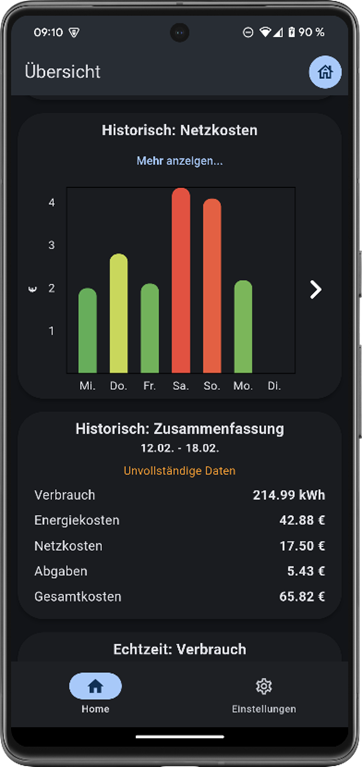
A summary of the total costs (weekly) can be found in the lower section of the app under “Historical: Summary” (see screenshot of the app). All cost components (energy costs, grid costs, levies, and total costs) are shown including VAT, i.e., on a gross basis. The representation of the cost components in the app is not legally binding; deviations may occur.
Please note: For participants in a Renewable Energy Community (REC), it is not possible for us to correctly display the cost components for electricity exchanged within the community. Therefore, the cost components for REC members are only shown for the quantities obtained from the residual electricity supplier (you can recognize this by the small community symbol next to the respective cost components). Please also note that the savings for REC members cannot be displayed with full accuracy.
Clever-PV app and existing home automation systems
Clever-PV is a cloud-based energy management system that is linked to the dynamic electricity grid fees as part of the INNOnet project. What does that mean? By connecting your generation and/or consumption units to the internet with the clever-PV app (another app, not to be confused with the "Project-INNOnet app"), you can automate their control with just a few settings. For example, you can integrate your photovoltaic system, electric car, or heat pump. As a demo participant, you will receive free access to clever-PV for the entire demo period, so there are no costs associated with using it during the demo.
If you use clever-PV as a demo participant, you can automate the control of your generation and/or consumption units based on the new dynamic grid fees with the click of a button. For instance, your heat pump would then prefer to operate during times of low grid fees, saving you costs automatically.
You can download the clever-PV app for free from the Apple App Store or Google Play Store and register.
This function will be available by March 2025 at the latest. This answer to this question will then be expanded.
If you are using or want to use clever-PV as an energy management system, refer to the question "What is clever-PV and what do I get from using it as a demo participant" or "How can I register for clever-PV".
If you are using, or would like to use, clever-PV as a home automation system, please refer to the questions “What is clever-PV and what are the benefits of using it as a demo participant?” or “How can I register with clever-PV?”.
For all other home automation system users, an API is available that allows the INNOnet tariff signal to be automatically retrieved and integrated into existing home energy management systems. If you are interested or have any questions, please contact our support team via email: Projekt.INNOnet(at)ait.ac.at
Customer interface/Smart Meter Adapter (SMA)
Congratulations! You are one of 50 demo participants who have been selected. A customer interface allows you to almost real-time monitor your electricity consumption. When you install the customer interface, which will be sent to you by mail, you can track your consumption data not only for the previous day but almost in real-time using the mobile INNOnet project app!
Here you can find additional information on the customer interface: LINK
Here you can find additional information on the customer interface from the grid operator LINZ NETZ GmbH: LINK
